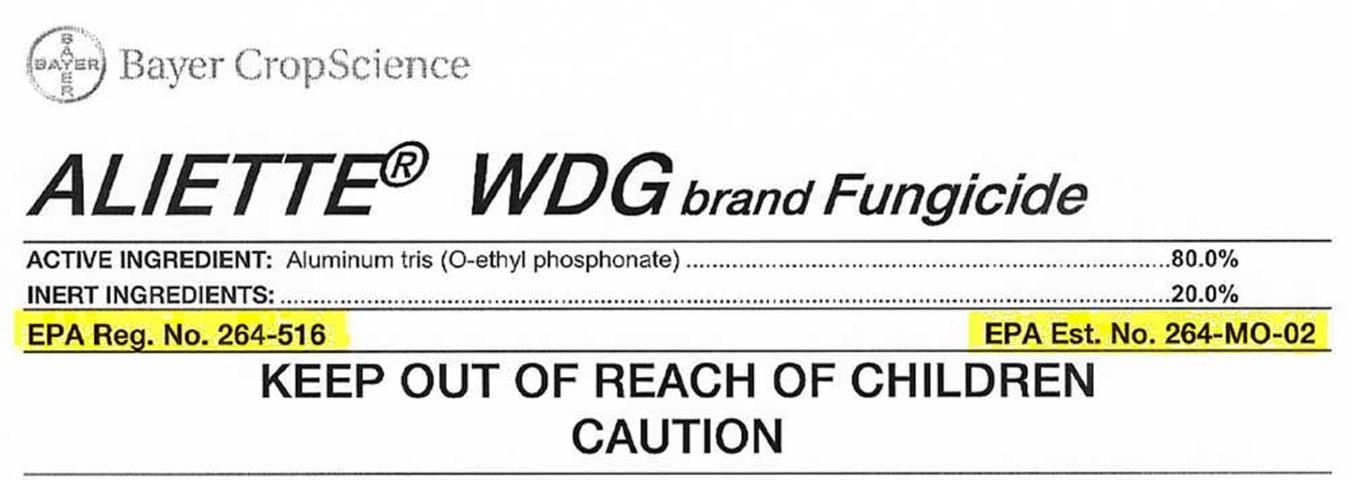This document describes identification numbers seen on the pesticide label. Examples of various identification numbers are provided and their meanings explained.
Introduction
The EPA registration number and the establishment number (Figure 1) are required on all pesticide products. The purpose of an identification number is to provide a unique product number for regular registrations, distributor registrations, Special Local Need registrations, and Experimental Use Permits.

EPA Registration Number
The EPA registration number indicates which company holds the registration for the pesticide product, and in which sequence the product was submitted to the EPA by the company. Before a pesticide product is registered under the Federal Insecticide, Fungicide, and Rodenticide Act (FIFRA), it is assigned an EPA file symbol which is comprised of the company number followed by a series of letters representing the potential product number. Product numbers are assigned sequentially to each company. The letters are used to indicate that the product is not registered. The letters come from the word, "REGULATION." Each letter represents a number starting with "1 (one)," and ending in "0 (zero)." Accordingly, R=1, E=2, G=3, U=4, L=5, A=6, T=7, I=8, O=9, and N=0. Therefore, if 6767-EGN were registered, it would become EPA Registration Number 6767-230. "6767" is the number identifying the company holding the registration and "230" is the number identifying that specific product. EPA has no required location for companies to place their registration number on the label, but it is usually found on the front or back panel of the product label, and near the company's name and address.
Distributor Numbers
FIFRA permits distribution or sale of a registered product under a distributors name and address. This is called "supplemental distribution." Distributor labels must be the same as that for the federally-registered product except for: product name, name and address of distributor, distributor number, establishment number, and any claims that are deleted from the label. No new claims may be added. Distributors may not amend their product labels separately. Only the basic registrant can amend a product's registered label. Distributor products will bear the EPA registration number of the basic product, followed by a dash, and then followed by the distributor's company number. For example, Company A has a registered product, Kill It Dead Herbicide, EPA registration number 262-598. Company A enters into a supplemental distribution agreement with Company B as a distributor. EPA receives all of the documentation explaining the arrangements between the two companies, and then assigns to Company B the number, 10007. Company B then markets the herbicide with the name, "Make It Brown Herbicide." Company B's registration number for that product will then have three sets of numbers partitioned by dashes that readily identify the product as a distributor product. In this case, the registration number would be 262-598-10007. If there were to be any amendments to the label, they would have to be done by Company A.
EPA Establishment Number
The establishment number indicates the final establishment at which the product was produced. A facility that produces pesticides must have a company number before an EPA establishment number is assigned. This number is often grouped together with the EPA registration number, but that is not a requirement. State abbreviations, such as FL, MS, or NC, will appear after the company number. The example shown in Figure 1 contains "MO," indicating that the product was manufactured in Missouri.
Special Local Need (SLN) Registration Number
The SLN registration number is also known as a FIFRA Section 24(c) registration number (see EDIS Document PI-95, Special local need pesticide registrations–24(c) https://edis.ifas.ufl.edu/PI132). The number is written as "EPA SLN No." followed by the two letter state designation, then the last two digits of the year of issuance, and finally a four digit number which is the consecutive number of registrations that the registering state has issued in that particular year. For example, if the company ABC applied for a section 24(c) registration in Florida and it was the 34th SLN registration accepted by Florida in the year 1995, then the 24(c) registration number would by EPA SLN No. FL950034.
Experimental-Use Permit Number
An experimental use-permit allows a company to develop data on either a new product or a new use site for a future full product registration (see EDIS Document PI-56, Experimental-use permits https://edis.ifas.ufl.edu/PI093). For example, the company ABC has a company number of 98979 and applies for an experimental-use permit to collect data on the crop lettuce and no tolerance is yet established for lettuce. The experimental-use permit number that EPA assigns to the product would be 98979-EUP-152, indicating this is the 152nd permit for which this company has applied.
Additional Information
Fishel, F.M. (2005). Experimental-use permits. PI-56. Gainesville: University of Florida Institute of Food and Agricultural Sciences. https://edis.ifas.ufl.edu/PI093.
Fishel, F.M. (2005). Interpreting pesticide label wording. Document PI-34. Gainesville: University of Florida Institute of Food and Agricultural Sciences. https://edis.ifas.ufl.edu/PI071
Fishel, F.M. (2005). Special local need pesticide registrations–24(c). PI-95. Gainesville: University of Florida Institute of Food and Agricultural Sciences. https://edis.ifas.ufl.edu/PI132

